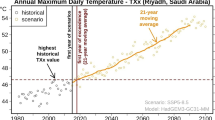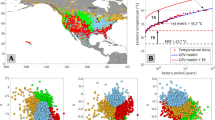Abstract
Current international efforts to reduce greenhouse gas emissions and limit human-induced global-mean near-surface temperature increases to 2°C, relative to the pre-industrial era, are intended to avoid possibly significant and dangerous impacts to physical, biological, and socio-economic systems. However, it is unknown how these various systems will respond to such a temperature increase because their relevant spatial scales are much different than those represented by numerical global climate models—the standard tool for climate change studies. This deficiency can be addressed by using higher-resolution regional climate models, but at great computational expense. The research presented here seeks to determine how a 2°C global-mean temperature increase might change the frequency of seasonal temperature extremes, both in the United States and around the globe, without necessarily resorting to these computationally-intensive model experiments. Results indicate that in many locations the regional temperature increases that accompany a 2°C increase in global mean temperatures are significantly larger than the interannual-to-decadal variations in seasonal-mean temperatures; in these locations a 2°C global mean temperature increase results in seasonal-mean temperatures that consistently exceed the most extreme values experienced during the second half of the 20th Century. Further, results indicate that many tropical regions, despite having relatively modest overall temperature increases, will have the most substantial increase in number of hot extremes. These results highlight that extremes very well could become the norm, even given the 2°C temperature increase target.




Similar content being viewed by others
References
Adams RM, McCarl BA, Mearns LO (2003) The effects of spatial scale of climate scenarios on economic assessments: An example from US agriculture. Climatic Change 60:131–148
Battisti DS, Naylor RL (2009) Historical warnings of future food insecurity with unprecedented seasonal heat. Science 323:240–244
Bauser CM et al (2009) Bayesian multi-model projection of climate: bias assumptions and interannual variability. Clim Dyn 33:849–868
Ben Ari T et al (2008) Human plague in the USA: the importance of regional and local climate. Biol Lett 4:737–740
Christidis N et al (2010) Probablistic estimates of recent changes in temperature: a multi-scale attribution analysis. Clim Dyn 34:1139–1156
Clark RT, Murphy JM, Brown SJ (2010) Do global warming targets limit heatwave risk? Geophys Res Lett 37:L17703
Collins WD et al (2006) The formulation and atmospheric simulation of the community atmosphere model version 3 (CAM3). J Climate 19:2144–2161
Council of the European Union (2005) Presidency conclusions—Brussels 22 and 23 March 2005
Diffenbaugh NS, Ashfaq M (2010) Intensification of hot extremes in the United States. Geophys Res Lett 37. doi:101029/2010GL043888
Ebisuzaki W (1997) A method to estimate the statistical significance of a correlation when the data are serially correlated. J Climate 9:2147–2153
Fan Y, van den Dool H (2008) A global monthly land surface air temperature analysis for 1948-present. J Geophys Res 113:D01103
Giorgi F (1990) Simulation of regional climate using a limited area model nested in a general circulation model. J Clim 3:941–963
Giorgi F, Coppola E (2010) Does the model regional bias affect the projected regional climate change? An analysis of global model projections. Climatic Change 100:787–795
Intergovernmental Panel on Climate Change (IPCC) (2007a) In: Solomon S, Qin D, Manning M, Chen Z, Marquis M, Averyt KB, Tignor M, Miller HL (eds) Climate change 2007: the physical science basis contribution of working group I to the fourth assessment report of the intergovernmental panel on climate change. Cambridge University Press, Cambridge, United Kingdom and New York, NY, USA
Intergovernmental Panel on Climate Change (IPCC) (2007b) In: Parry ML, Canziani OF, Palutikof JP, der Linden PJvan, Hanson CE (eds) Climate change 2007: impacts adaptation and vulnerability contribution of working group II to the fourth assessment report of the intergovernmental panel on climate change. Cambridge University Press, Cambridge, United Kingdom and New York, NY, USA
Jenkinson AF (1955) The frequency distribution of the annual maximum (or minimum) values of meteorological elements. Quart J Roy Meteor Soc 87:145–158
Kiktev D et al (2007) Comparison of observed and multimodeled trends in annual extremes of temperature and precipitation. J Geophys Res 34:L10702
Knutti R et al (2010) Challenges in combining projections from multiple climate models. J Climate 23:2739–2758
Kushnir Y (1994) Interdecadal variations in North Atlantic sea surface temperature and associated atmospheric conditions. J Climate 7:141–157
Liang X-Z et al (2008) Regional climate models downscaling analysis of general circulation models present climate biases propagation into future change projections. Geophys Res Lett 35:L08709
Lobell DB, Burke MB (2008) Why are agricultural impacts of climate change so uncertain? The importance of temperature relative to precipitation. Environ Res Lett 3. doi:10.1088/1748-9326/3/3/034007
Lorenz R, Jaeger EB, Seneviratne SI (2010) Persistence of heat waves and its link to soil moisture memory. Geophys Res Lett 37:L09703
Mantua NJ et al (1997) A Pacific interdecadal climate oscillation with impacts on salmon production. Bull Am Meteor Soc 78:1069–1079
Meehl GA et al (2009) Decadal prediction: can it be skillful? Bull Am Meteor Soc 90:1467–1485
Mitchell TD (2003) Pattern scaling: an examination of the accuracy of the technique for describing future climates. Climatic Change 60:217–242
Murphy JM et al (2004) Quantification of modeling uncertainties in a large ensemble of climate change simulations. Nature 430:768–772
Nakićenović N et al (2000) Special report on emissions scenarios: a special report of Working Group III on the intergovernmental panel on climate change. Cambridge University Press, Cambridge
Pan ZT et al (2004) Altered hydrologic feedback in a warming climate introduces a “warming hole”. Geophys Res Lett 31:L17109
Sanderson MG, Hemming DL, Betts RA (2011) Regional temperature and precipitation changes under high-end (>4°C) global warming. Phil Trans Roy Soc A 369:85–98
Schlenker W, Roberts MJ (2006) Nonlinear effects of weather on corn yields. Rev Ag Econ 28:391–398
Seneviratne SI et al (2006) Land-atmosphere coupling and climate change in Europe. Nature 443:205–209
Sherwood SC, Huber M (2010) An adaptability limit to climate change due to heat stress. Proc Nat Acad Sci 107:9552–9555
Smith JB et al (2009) Assessing dangerous climate change though an update on the International Panel on Climate Change (IPCC) “reasons for concern”. Proc Natl Acad Sci USA 106:4133–4137
Stenseth NC et al (2002) Ecological effects of climate fluctuations. Science 297:1292–1296
Tebaldi C, Hayhoe K, Arblaster J, Meehl G (2006) Going to the extremes: an intercomparison of model-simulated historical and future changes in extreme events. Climatic Change 7:9185–211
United Nations Framework Convention on Climate Change (UNFCCC) (2009) The Copenhagen Accord 5 pp U N Geneva Switzerland
Wang H et al (2009) Attribution of the seasonality and regionality in climate trends over the United States during 1950–2000. J Climate 22:2571–2590
Wilby RL, Wigley TML (1997) Downscaling general circulation model output: a review of methods and limitations. Prog Phys Geog 21:530–548
Woollings T (2010) Dynamical influences on European climate: an uncertain future. Phil Trans Roy Soc A 368:3733–3756
Xu JC et al (2009) The melting Himalayas: cascading effects of climate change on water, biodiversity, and livelihoods. Cons Bio 23:520–530
Acknowledgements
I thank Robert K. Kaufmann for his insightful comments on the manuscript, along with those of the three anonymous reviewers. I also acknowledge the modeling groups, the Program for Climate Model Diagnosis and Intercomparison (PCMDI) and the WCRP's Working Group on Coupled Modeling (WGCM) for their roles in making available the WCRP CMIP3 multi-model dataset. Support of this dataset is provided by the Office of Science, U.S. Department of Energy.
Author information
Authors and Affiliations
Corresponding author
Electronic supplementary material
Below is the link to the electronic supplementary material.
Esm 1
Intensification of seasonal extremes given a 2°C global warming target (DOC 674 kb)
Rights and permissions
About this article
Cite this article
Anderson, B.T. Intensification of seasonal extremes given a 2°C global warming target. Climatic Change 112, 325–337 (2012). https://doi.org/10.1007/s10584-011-0213-7
Received:
Accepted:
Published:
Issue Date:
DOI: https://doi.org/10.1007/s10584-011-0213-7




